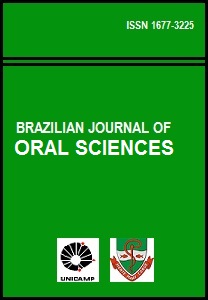Abstract
The purpose of this study is to analise the nasolabial angle and other cephalometric measurements that express the anteroposterior relationship of maxilla and mandibule in individuals with finger sucking habit. Thirty lateral cephalograms were selected from the patient files of the scientific documentation service, Orthodontic Graduation Course of the Piracicaba College of Dentistry, FOP/UNICAMP. The selection criteria was white Brazilian female subjects, 7 to 10 years old, in the phase of mixed dentition, and presenting finger sucking habit. The observed cephalometric measurements were: nasolabial angle, SNA, SNB, ANB, 1.NA, 1-NA and Nperp-A. The results were compared using Student’s ‘t’ test and, significance level of 5% (á = 0,05). The analysis showed no differences in the nasolabial angle in subjects presenting finger sucking habit; the maxilla and mandibule was well positioned, relative to the cranial base, and the upper incisors were well positioned.References
Moyers RE. Ortodontia. 4. ed. Rio de Janeiro: Guanabara Koogan; 1991.
Proffit W. Ortodontia contemporânea. 3. ed. Rio de Janeiro: Guanabara Koogan; 2000.
Warren JJ, Bishara SE. Duration of nutritive and nonnutritive sucking behaviors and their effects on the dental arches in the primary dentition. Am J Orthod Dentofacial Orthop 2002; 121: 347-56.
Larsson E. Artificial sucking habits: etiology, prevalence and effect on occlusion. Int J Orofacial Myology 1994; 20: 10-21.
Siqueira VCV, Negreiros PE, Benites WRC. A etiologia da mordida aberta na dentadura decídua. RGO 2002; 50: 99-104.
Chevitarese AB, Della Valle D, Moreira TC. Prevalence of malocclusion in 4-6 year old Brazilian children. J Clin Pediatr Dent 2002; 27: 81-5.
Betzenberger D, Ruf S, Pancherz H. The compensatory mechanism in high-angle malocclusions: a comparison of subjects in the mixed and permanent dentition. Angle Orthod 1999; 69: 27-32.
Klocke A, Nanda RS, Kahl-Nieke B. Anterior open bite in the deciduous dentition: longitudinal follow-up and craniofacial growth considerations. Am J Orthod Dentofacial
Orthop 2002; 122: 353-8.
McNamara JR JA. A method of cephalometric evaluation. Am J Orthod 1984; 86: 449-69.
Capelozza Filho L, Araujo Almeida G, Mazzottini R, Cardoso Neto J. Maxillomandibular relationships in patients with dentofacial deformities: diagnostic criteria utilizing the cephalometric analysis. Int J Adult Orthod Orthognath Surg 1989; 4: 13-26.
Elias AC. The importance of the nasolabial angle in the diagnosis and treatment of malocclusion. Int J Orthod 1980; 18: 7-12.
Silva Filho OG, Okada T, Tocci LFC. Avaliação cefalométrica do ângulo nasolabial aos 7anos, 12anos e 19 anos, numa amostra de oclusão normal. Rev SBO 1990; 1: 108-13.
Midtgard J, Björk G, Linder-Aronson S. Reproducibility of cephalometric landmarks and errors of measurements of cephalometric cranial distances. Angle Orthod 1974; 44: 56-67.
Magnani MBBA, Azevedo V, Pereira Neto JS, Valdrighi HC. Alterações cefalométricas decorrentes do hábito de sucção digital, em indivíduos na faixa etária de 7 a 10 anos de idade. Rev Paul Odontol 1998; 20: 24-33.
Martins DR, Janson GRP, Almeida RR, Pinzan A, Henriques JFC, Freitas MR. Atlas de crescimento craniofacial. São Paulo: Santos; 1998.
The Brazilian Journal of Oral Sciences uses the Creative Commons license (CC), thus preserving the integrity of the articles in an open access environment.

